
Cycling in urban environments can be one of life’s greatest joys. Feeling the wind in your hair, seeing a city in a beautiful new way, and exploring the nooks and crannies beyond well-trodden paths are all things that city cyclists love about travelling on two wheels.
In this piece, we’ll explore some of the best cities in the world for cyclists – from infrastructure to environment to culture, these are the best spots across the globe to take your bike on an urban adventure.
What Makes a “Bike-Friendly City”?
When we’re deciding what makes a ‘bike friendly city’, we’re looking for the following things:
- Great cycling infrastructure, including protected lanes
- Deprioritisation of cars in favour of bicycles
- Popularity of cycling for all kinds of reasons
- Cycling safety
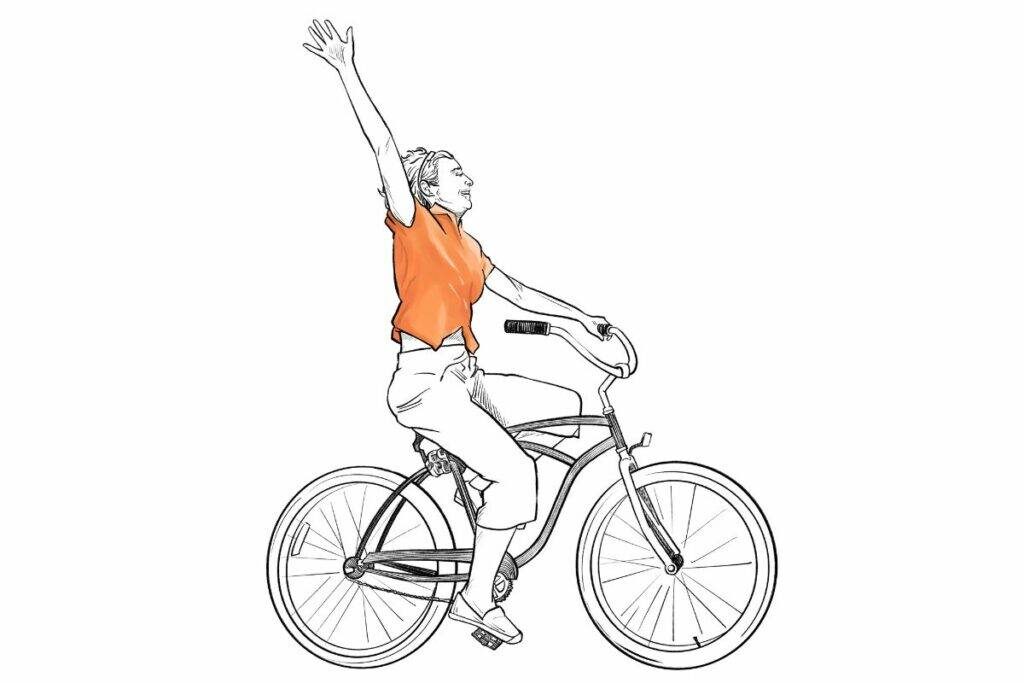
The Best Bike Lanes in the World
So, where can you find the “best bike lanes in the world”? Below, we’ve listed the top 12 locations, including some well-known cycling cities and some surprising ones you might not have expected…
1. Utrecht
A Dutch city takes top spot on this list, but maybe not the one you were expecting… Utrecht has been ranked the most bike-friendly city in the world by Luko’s Global Bicycle Cities Index 2022.
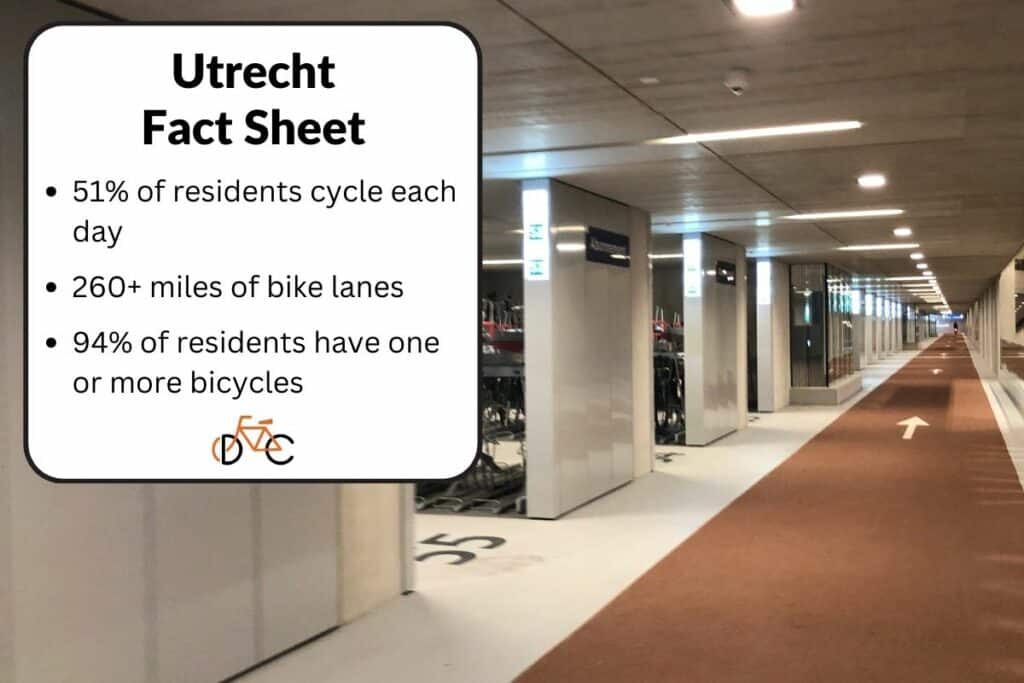
Cycling in Utrecht
Around 51 per cent of Utrecht’s population are cyclists, which is just staggering. There’s over 420 km of cycle paths, plenty of parking facilities, and the city is also home to the Netherlands’ first official cycle path, which was built in 1885 on the Maliebaan.
33,000 cyclists cycle along Utrecht’s busiest route every day, and 56% of Utrecht residents visit the city centre by bicycle, making it the most popular way to visit this area.
Utrecht Bike Lanes
Utrecht already has lots of cycle paths and a great attitude towards cycling from residents, but it’s still investing in improvements. The city is implementing smart traffic signals, dedicated fast lanes for e-bikes, and is expanding the number of bicycle parking spaces to record breaking levels.
Bikes are prioritised over cars, and local politicians aim to double the use of bicycle commuting traffic by 2030.
Utrecht Cycling Statistics
- 87% of Utrecht residents are satisfied with the city centre’s accessibility by bike
- 94% of Utrecht residents have one or more bicycles
- 51% of the population cycle
- Utrecht has 420km of cycle paths, and this is only set to increase and improve
2. Copenhagen
Copenhagen regularly tops lists of the world’s best cycling cities, and it’s easy to see why.
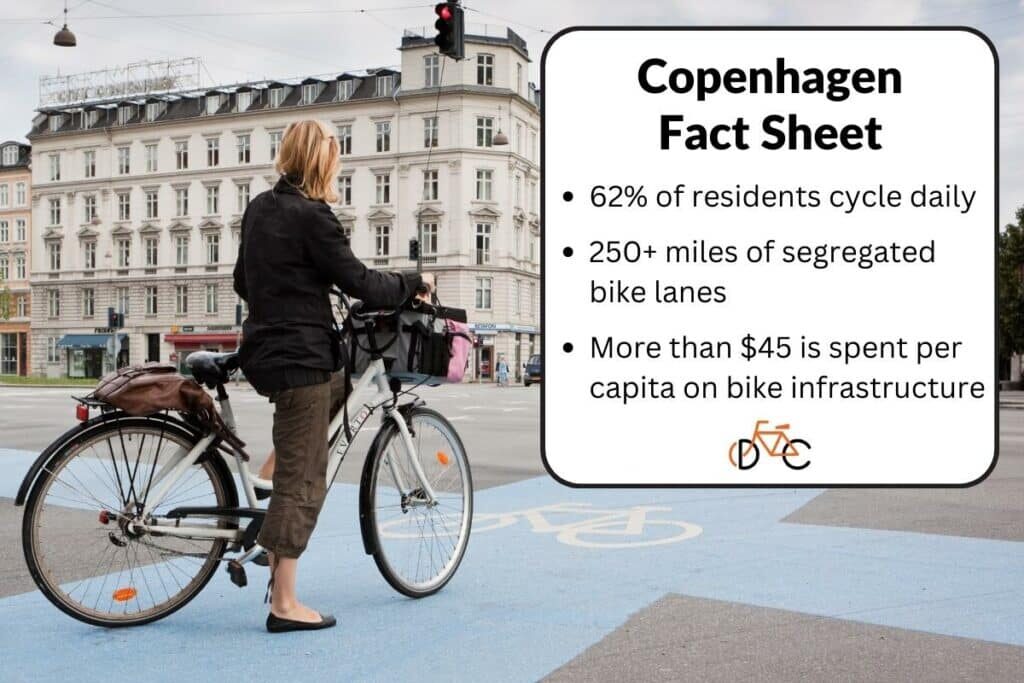
Cycling in Copenhagen
62% of Copenhagen’s residents’ trips to work or school are by bike, and people in the Danish capital cycle 894,000 miles every day. Those are really impressive statistics, and ones made possible by excellent cycling infrastructure.
More than $ 45 per capita is spent on bicycle infrastructure investments, which is spent on hundreds of miles of cycle lanes, many of which are separated from car lanes and pavements for a safe cycling experience.
Copenhagen Bike Lanes
Currently, Copenhagen boasts 220 miles of curb segregated cycle tracks, 14 miles of on-street cycle lanes and 27 miles of off-street green cycle routes running through parks and green spaces.
The city plans to expand this offering with 43 miles of cycle tracks and 42 miles of green routes by 2026, so the best is yet to come in this already amazing city for cycling.
Copenhagen Cycling Statistics
- An average of 5.7 million kilometres are cycled between each serious accident
- More than three quarters of Copenhagen residents feel safe while cycling
- 62% of Copenhagen residents’ commutes to work or school are by bike
- 9 out of 10 people in Copenhagen own a bike
- There are over 250 miles of cycle lanes in the city
3. Amsterdam
When you think of cycling cities, you probably think of Amsterdam. Let’s have a look at what makes the Dutch capital so great for cycling.
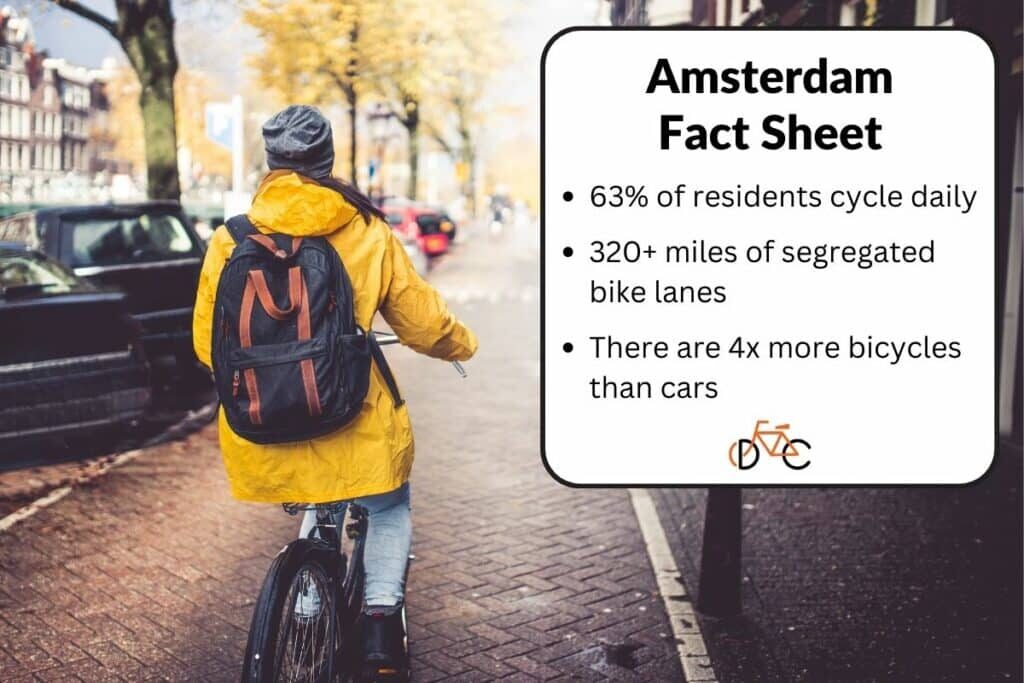
Cycling in Amsterdam
It’s reported that there are more bikes in Amsterdam than people, which is really quite mind blowing. The city made global headlines in January 2023 as it opened an underwater bike garage serving its central station, providing cheap, safe parking for 7,000 bicycles.
Amsterdam is also adding to its already impressive cycling infrastructure by adding new routes, widening existing cycle tracks, building low-speed cycle streets and redesigning major intersections to allow for more protected cycling space.
Amsterdam Bike Lanes
Amsterdam has approximately 320 miles of dedicated cycle lanes, and as with all major Dutch cities, it has designated ‘bicycle civil servants’ to help maintain and improve the network.
Bike lanes in Amsterdam have special cycle traffic lights, and sometimes are even physically separate from both road and pavement. They’re typically one-way but there are some two-lane bike paths too.
Amsterdam Cycling Statistics
- 63% of Amsterdam residents cycle daily
- There are 1.91 bicycles per household in Amsterdam
- There are four times more bikes in Amsterdam than cars
- Combined, Amsterdam’s cyclists bike two million kilometres a day
4. Strasbourg
For a long time, Strasbourg has been France’s top cycling city — here’s why.
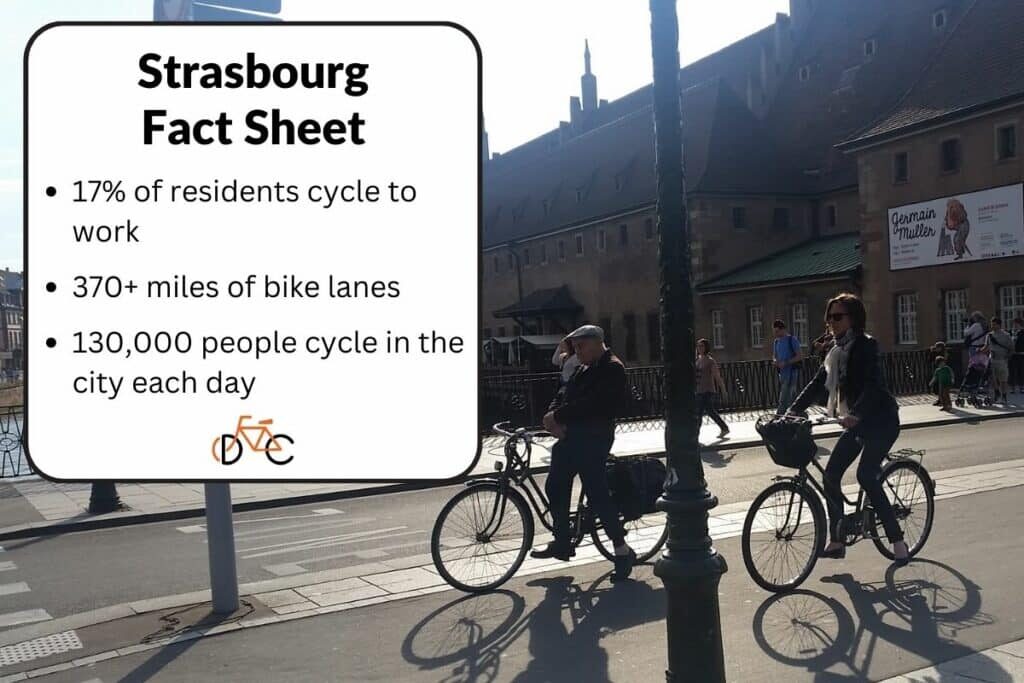
Cycling in Strasbourg
Strasbourg has its urban cycling network totally sorted, and has expanded its strategy to other areas including modernisation, encouraging new riders, expanding cycle highways into suburbs, and taking a closer look at the benefits of cargo bikes.
The bicycle is the most popular form of transport in Strasbourg, and there are lots of brilliant ways to see the city this way whether you’re a local commuting to work or a tourist wanting to explore all the sights.
Strasbourg Bike Lanes
With 600 km of bike paths covering the whole urban area of Strasbourg, there is plenty of ground to cover on your bicycle here. It’s ranked the most bike friendly city in France, and the fourth most bike friendly city in Europe, backed by a huge cycling culture across all walks of life.
Bike lanes go through urban areas, along canals, through parks and green spaces and more, so there’s no reason not to see the city from your saddle.
Strasbourg Cycling Statistics
- More than 17% of people cycle to work in Strasbourg
- 130,000 people ride on the city’s bike routes every day
- Strasbourg has 600 km of bike paths
5. Paris
Back to France, and this time to the capital, which has seen something of a transformation, as our video below explains:
Cycling in Paris
Cyclists in Paris used to have to share their lanes with buses, but now the French capital is getting plenty more dedicated cycle tracks, including protected lanes on the Champs-Elysées. These new cycling facilities have yielded amazing results, with cyclists making up a higher percentage of traffic in some areas and Parisian children riding their bikes more than ever before.
Paris Bike Lanes
From 2015 to 2020, the Paris cycling plan saw 150 million Euros invested in Paris’s bike lanes, doubling the number of cycle paths and renewing Parisians’ interest in cycling. Now, for the next five years, the city aims to make Paris a “100% cycling city”, investing in infrastructure, parking solutions and improving the cycling ecosystem.
This plan will build on the current 1,000 km of bike lanes and 300 km of bike tracks already available in the city.
Paris Cycling Statistics
- As of 2021, around 15% of journeys in Paris are made by bike
- Between now and 2026, Paris will gain 180 km of permanent segregated bike lanes
- Around 1 million people in Paris ride bikes on a daily basis
6. Oslo
Next up is Oslo, where the Nordic climate doesn’t stop the cyclists.
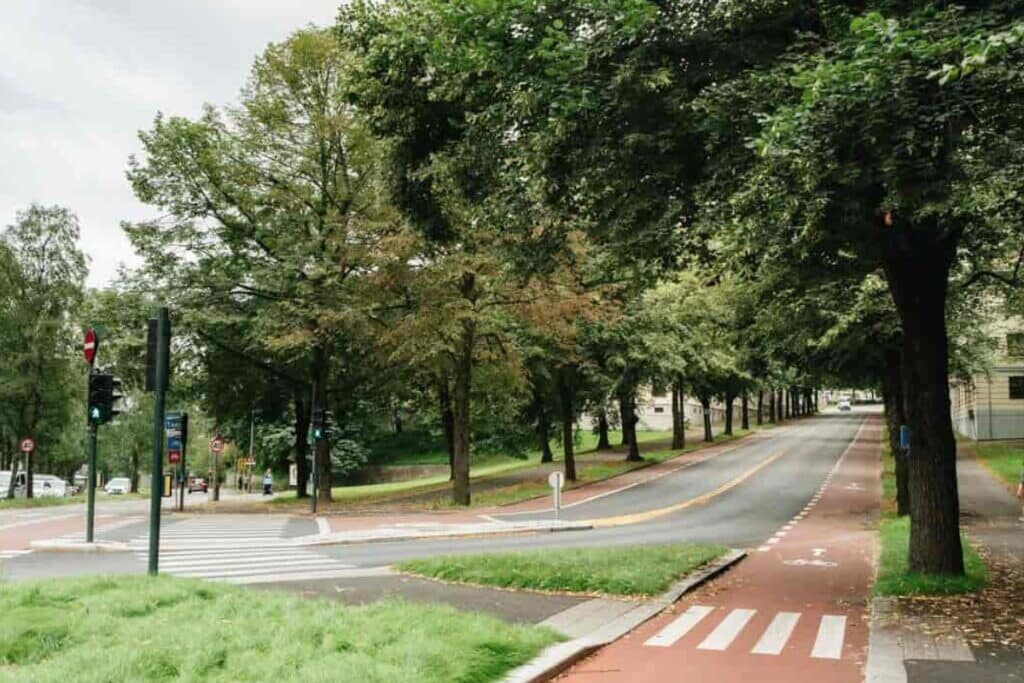
Cycling in Oslo
Oslo sets a great example in overcoming tough weather conditions to provide great cycling opportunities. In 2017, cars were banned from much of Oslo’s urban centre, and investments were made in traffic calming throughout the city and removing over 1,000 parking spaces in favour of biking and walking.
Oslo Bike Lanes
Oslo has lots of scenic cycle routes, and it’s a short distance between the city centre and the beautiful Norwegian countryside.
Since 2015, Oslo has implemented 50 km of bike lanes, removed parking spaces equivalent to 4,250, and lowered speed limits so nearly two thirds of the road network is under 30 km/hr, making the city much more cyclist-friendly.
Oslo Cycling Statistics
- Bicycle traffic increased 77% between 2014 and 2020
- In the same period, the number of citizens agreeing that ‘cycling in Oslo is safe’ increased from 9% to 28%
- In 2019, Oslo held 7th place for best bicycle city in the Copenhagenize Bicycle Friendly Index, up from 19th in 2017
7. Montreal
This Canadian city is great for cyclists.
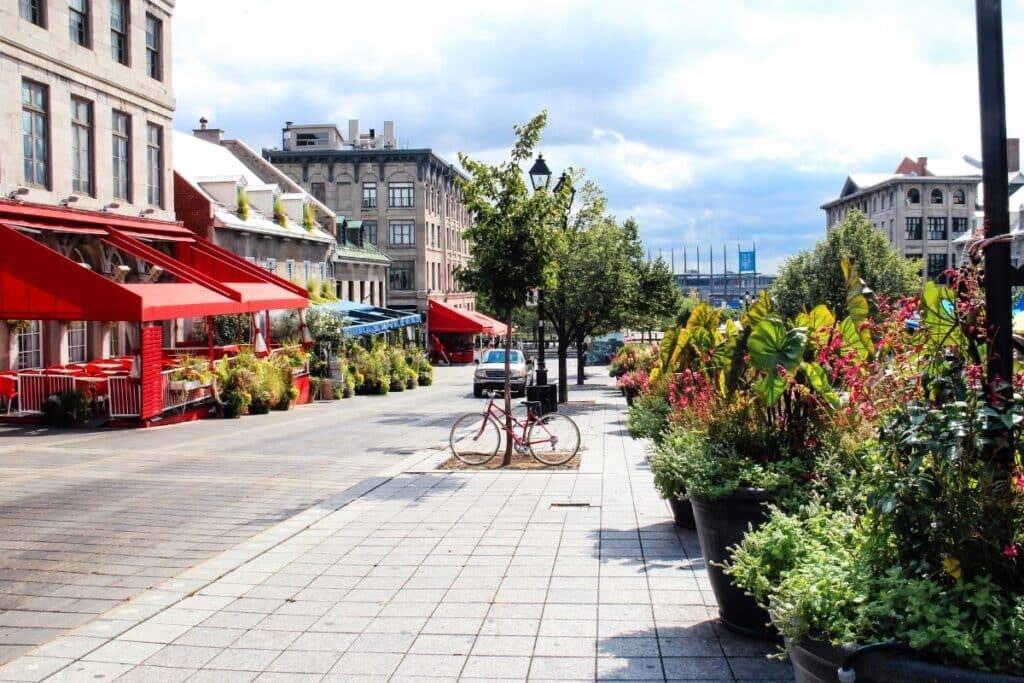
Cycling in Montreal
In 2017, Montreal elected its new Mayor, Valérie Plante, who had lots of positive ideas around bicycle infrastructure and investment in public transport, resulting in a bold cycling-focused project. There is a thriving bike culture, and the infrastructure is only getting better.
Montreal Bike Lanes
To be completed later this decade, the REV, Réseau express vélo, is a 184 km bike path project that connects various points of interest in the city and will complement the 50 or so miles of protected bike lanes already available.
The rest of the network comprises 1,001 km of bike lanes, many of which are available year round — come snow or sunshine.
Montreal Cycling Statistics
- There were 1.1 million people who rode bikes in Montreal in 2020
- In 2020, 600,000 people used a bike as a means of transportation in the city, which is a 42-per-cent increase from 2015
- Most of Montreal’s cyclists are weekend riders
8. Bordeaux
Another French city makes the list! Here’s why Bordeaux is so great for cyclists.
Cycling in Bordeaux
Bordeaux is working to prioritise cycling as a mode of transportation, and the recent banning of cars from the historic Pont de Pierre bridge was a huge milestone, allowing for a 20% increase in cycle traffic in the area. Plus, the city’s administration continues to remove car space to allow for more sustainable transport options, so it’s one to watch.
Bordeaux Bike Lanes
In Bordeaux, there are around 200km of cycle paths offering lovely routes for biking. There is room for improvement, though, as the majority are just painted lanes and not protected cycle tracks, and residents hope for better cycle links to more suburban areas.
Bordeaux Cycling Statistics
- Ranked sixth most cycling-friendly city in the world in 2017
- Only 22 miles of cycle tracks
- Bordeaux’s Cycling Plan 2017-2020 announced 70 million Euros of spending on cycling in the city
9. Helsinki
Another Nordic capital makes the list – we’re heading to Finland,
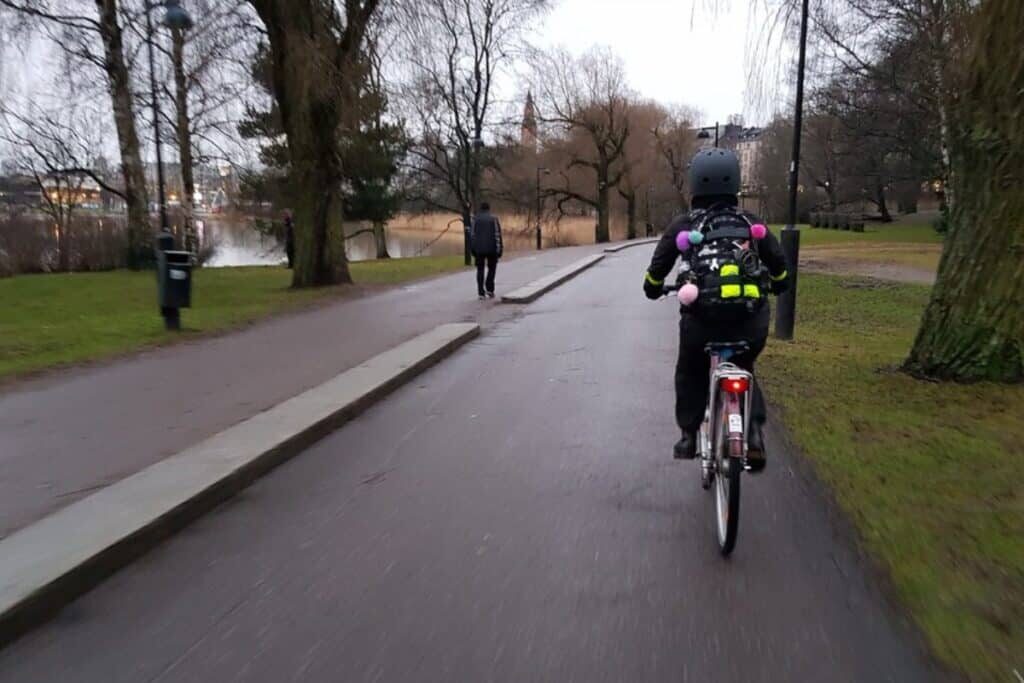
Cycling in Helsinki
Helsinki aims to be the world’s best city for sustainable transport, and is working to improve its already good share of people using bicycles to get around the city.
There’s a vibrant cycling community in the Finnish capital, which only bodes well for the city’s progression.
Helmet usage is very high in Helsinki, and people cycle all year round, despite the fact that the city’s popular bike share scheme shuts down in the freezing winter months.
Helsinki Bike Lanes
The Finnish capital has over 800 miles of bicycle infrastructure and 12 miles of cycle highways – with another 87 miles planned – and is targeting central corridors for more bicycle-focused roads.
Helsinki Cycling Statistics
- 25% of Helsinki’s residents cycle daily or almost daily, while 29% cycle 2-3 times per week
- Cycling makes up 11% of all journeys made in Helsinki, 19% of commutes to work and 20% of commutes to school
- Despite the cold winter temperatures, 13% of Helsinki’s adult residents cycle all year round
10. Portland
Portland loves cyclists, and cyclists love Portland.
Cycling in Portland
Portland is a great city for cycling whether you’re a resident commuting to work or a tourist looking to explore on two wheels. It has an extensive system of bike routes and encourages cycling culture through a variety of events, from the Pedalpalooza Bike Festival to Portland’s World Naked Bike Ride for more adventurous riders!
Portland Bike Lanes
Portland has miles of protected bike lanes, beautiful parks to explore on two wheels, and fantastic bike routes through some of the city’s most iconic neighbourhoods.
The network comprises nearly 400 miles of bikeways, including 100 miles of low-stress neighbourhood greenways as well as multi use paths. Most Portlanders live within a quarter of a mile of a bikeway!
Portland Cycling Statistics
- As of 2017, 6.3% of Portland commuters go by bike – the highest percentage of bike commuters for a large American city
- 374% more people biked to work in 2017 than in 2000
- 80% of cyclists in Portland wear helmets
- 35% of Portland’s cyclists are female
11. Bogotá
Next, we’re off to the capital of Colombia, which is making huge cycling gains in recent years.
Cycling in Bogotá
While Bogotá is still very car-heavy, it deserves an honourable mention for the gains it’s made in improving its cycling culture.
Bogotá has become world famous for popularising the ciclovía, a weekly event on Sundays which sees over 60 miles of the city’s streets closed to cars, enabling citizens to explore by bike or on foot.
More than half of all Bogotá households have at least one bike, and there are lots of city bikes available to rent too.
Bogotá Bike Lanes
Bogotá’s city-wide cycling network comprises more than 600km of streets – one of the largest in the world, and the most extensive in Latin America.
During the Covid-19 pandemic, mayor Claudia López, a keen cyclist herself, created 84km of temporary lanes to allow for socially-distanced cycling, the majority of which have now been made permanent.
The city aims to add 280km of bike lanes by 2024, and hopes to have 50% of trips made by bike or alternative transport, such as scooters.
Bogotá Cycling Statistics
- In 2017, over 9% of trips in Bogotá were made on two wheels, and it’s estimated that this climbed to 13% in 2020
- Over 50% of all Bogotá households have at least one bike
- Bogotá’s weekly ciclovías are used by approximately 2 million people, about 20% of the population
12. Minneapolis
Let’s see what the American city of Minneapolis has to offer cyclists.
Cycling in Minneapolis
People in Minneapolis, Minnesota are dedicated to cycling. The city has been restructured to cater to cycling, with miles of bike paths and lovely routes to explore.
Minneapolis ranks as one of the best biking cities in the USA, and boasts the third-highest five-year average of bicycle commuting for large US cities according to the 2017 census.
Minneapolis Bike Lanes
Minneapolis has 98 miles of bike lanes, 101 miles of off-street bikeways and trails, and 16 miles of on-street protected bikeways, so it’s easy to see why riding a bike is one of the most popular ways to get around the city.
Minneapolis Cycling Statistics
- As of 2014, Minneapolis had 226 miles of bike lanes and trails
- It has more bike lanes and trails per square mile (5.8) than any other major city in the US
- Minneapolis is home to some of the largest pieces of bicycle infrastructure in the US, including the Midtown Greenway which is used by an average of 4,100 cyclists per day
Which City Has the Most Bike Lanes in the World?
With, 1,350 miles of bike lanes, New York is believed to have the most bikes lanes in the world.
Unfortunately, this doesn’t tell quite the whole story, with only 126 miles of on-street lanes protected with a physical barrier from motorists, and it’s rare to find a direct route that runs entirely, or even mostly, on bike lanes – so in a city that’s still so car-heavy, meaning cycling in New York can still be tricky.
The post The Best Bike Lanes in the World: 12 Cities Doing it Right appeared first on Discerning Cyclist.
